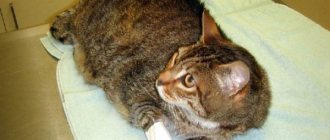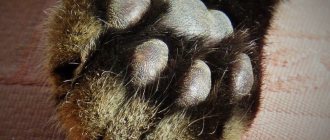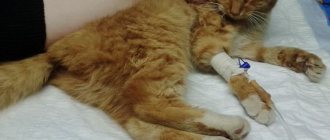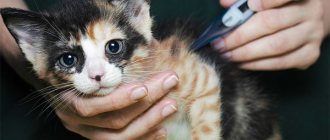9288Administration
1
If the owner notices that the cat’s paws are shaking, then it is necessary to urgently visit a veterinarian. This phenomenon should not be ignored. It also happens that a cat’s hind legs are shaking, but the front legs are not affected by the disorder. The tremors in the hind limbs that your cat suffers from will not go away on their own. If you start a violation, then there is a danger that gradually the paws, which at first only shake, will begin to fail, and the cat will simply end up half paralyzed, forced to lie down all the time. No owner would want such an outcome, and therefore, naturally, will make every effort to restore the normal state of the pet. It is important to know that when the paws shake, the trembling in them is not a cramp.
When asked why the owner sometimes notices tremors in the limbs of a kitten or an adult pet, the answer can be completely different, since the reasons range from harmless to pathological.
© shutterstock
Tremor in a cat
Tremors (tremors) are frequent muscle contractions that persist while awake.
True trembling stops during sleep. Tremor in cats is not always associated with pathology; there is so-called physiological tremors:
- In case of hypothermia
- With emotional stress
- For severe muscle strain/tension
Causes of true tremor
There are many causes of tremors in cats, depending on what part of the body is affected.
Head tremors
- Cerebellar abnormalities
- Idiopathic (cause unknown)
- Genetic causes
- Inflammatory processes (encephalitis)
- Injury
- Use of certain drugs
- Vestibular diseases
Tremor of the back of the body
- Weakness or pain.
- Metabolic disease (kidney failure, low blood sugar).
- Compression lesions of the spine (tumors, narrowing of the lumen of the spinal canal).
- Neuromuscular diseases.
Common Causes of Trembling
- Toxic (organophosphates, mycotoxins).
- Hypomyelination (diseases in which the myelin sheath of the nerves is reduced or absent).
- Degenerative neurological diseases.
Diagnostics
For an initial medical history and blood draw, you can call a veterinarian to your home. A detailed blood test, biochemical profile and urine test are recommended in all cases. It is important to rule out metabolic disorders such as hypoglycemia (low blood sugar) or kidney disease.
Usually, an X-ray examination of the chest and abdominal cavities does not reveal any pathologies, but it should be carried out, as well as an X-ray of the spine.
Myelography (x-ray examination of the spine using dye) may be recommended to evaluate the presence of a tumor or intervertebral disc disease.
A CT or MRI scan can help detect structural changes in the brain and/or spine.
A cerebrospinal fluid tap can confirm encephalitis.
Electromyography will help in diagnosing neuromuscular disorders.
How to cure tremors in a cat? It is necessary to identify and eliminate the root cause of this condition, if possible. It is also recommended to avoid agitation and increased activity, as they can worsen the tremors, so it is better to call a veterinarian at home for follow-up examinations. Intervertebral disc disease sometimes requires surgery.
Home care
Avoid exposing your cat to various toxins. If you suspect poisoning, immediately contact your veterinarian or call a doctor at home. Animals with general tremors often lose weight. Monitor your pet's weight and make appropriate dietary changes.
It is necessary to strictly adhere to the instructions of the attending physician.
source
The cat is shaking - a complete list of reasons from the veterinarian
Author - veterinarian Irina Barabash
Owners sometimes observe a kitten or adult cat trembling. If this happens rarely, it is not a cause for concern. The owners blame everything on chance or cold. However, some pathologies that first appear as tremors later cause seizures in the cat, and this can end sadly. In addition, there are diseases with such symptoms that are dangerous to humans. Therefore, trembling in cats cannot be ignored - you should immediately contact a veterinarian. And the MURKOTIKI website will tell you about the possible causes of the symptom.
The animal got scared
The second simplest explanation for trembling in an animal is intense fear. Such a tremor is invisible to the eye, but is felt as a small vibration in the pet’s body if you place your palm on it. In this case, it is worth finding out why the cat had this reaction. The reasons may be different:
READ The cat bleeds after castration causes symptoms care
- a change of scenery;
- the appearance of a new person in the house;
- presence of a foreign animal nearby;
- new item;
- unfamiliar smell.
Why do cats and cats tremble?
Trembling is also called tremor, that is, they are synonyms. What is tremor in cats? These are rhythmic movements of the body or its individual parts (head, paws, tail) caused by muscle contraction.
Sometimes why a cat is trembling all over can become clear only after a detailed examination of the body. Therefore, if there are no visible reasons, this does not mean that they do not exist at all. For example, there may be an incubation (hidden) period of rabies: trembling is one of the first symptoms that cannot be ignored.
Let's summarize. If a cat is trembling, there are internal or external reasons for this. As a rule, trembling is a consequence of:
- changes in air temperature and humidity;
- reactions to a stressful situation;
- sexual overstimulation;
- pathology (infectious, invasive, non-infectious).
The animal is cold
If the owner notices that an adult cat or kitten is shaking when it is wet, this is normal. This is how the body reacts to humidity and cold. Felines can withstand low temperatures well, but not high humidity.
In addition, small kittens have not yet developed a thermoregulation system - they are more sensitive to high humidity and low temperatures. But convulsions in kittens are no longer associated with cold: the reasons should be sought by examining the animal’s condition more deeply.
The cat also shakes from severe and prolonged hypothermia or from overheating. You should not leave your animal in the cold, in pouring rain or under the scorching sun. Overheating in cats causes heatstroke, which can lead to urinary spasms.
When to contact a veterinarian
The veterinarian will examine the animal and prescribe the necessary tests. As a result, it may turn out that the pet has diseased kidneys. Along with trembling, the pet becomes more aggressive and its behavior changes.
There is another reason why trembling may begin. And she's pretty serious. This is rhinotracheitis. This disease can affect both an adult animal and a kitten. It can develop in representatives of any breed. With this disease, the pet's respiratory system is affected.
In order to identify a disease in your pet as early as possible and begin to treat it, it is better to show it to the veterinarian as soon as you become suspicious and concerned. If your suspicions are not confirmed, you can calm down, and if they are confirmed, you will have a better chance that your pet will recover faster, and this will not affect his health.
A particularly observant owner will always be able to identify any changes that happen to his mustachioed pet. How to react to them?
The owner’s first thought will be to contact a veterinarian for an examination and determine the cause of the disease. But is it always necessary to seek qualified help? Frightening symptoms may not mean that the cat has any disease.
READ Can cats be given valerian and why do they love it?
If the owner, after analyzing his pet’s trembling on his own, does not find an explanation for it, he will have to immediately contact a specialist at the nearest veterinary clinic. As the animal begins to tremble, its behavior may change; overnight, a beloved cat may become aggressive. In addition to the reasons described above that cause tremors in a cat in a lying position, there are many other less harmless reasons that cause tremors.
These include:
- The cat has helminths.
- Lack of vitamins in the cat's body (especially calcium and vitamin B).
- Diseases of internal organs (in particular the kidneys - the presence of urolithiasis in the animal).
The veterinarian will send the animal along with the owner to undergo all the necessary tests and an ultrasound of the internal organs, and then give recommendations on the necessary treatment.
Causes of seizures in cats
If a cat has seizures, you need to look for the reasons quickly and using laboratory and clinical tests. Self-treatment using recipes from the Internet is unacceptable.
Convulsions in kittens and adult animals are observed with the following pathologies.
Damage to the brain or nervous system
In cases of inflammatory diseases of the meninges, in addition to seizures, cats exhibit other symptoms. Most likely, there will be a rise in temperature and hysterical meowing, indicating pain.
Meningitis and tick-borne encephalitis. Let us dwell separately on particularly dangerous diseases. Meningitis and encephalitis in a cat causes tremors of the entire body, and not just its individual parts. Therefore, if a cat is trembling all over for no apparent reason, urgent diagnosis is needed.
Lyme disease. Sometimes nervous phenomena and convulsions due to borreliosis (Lyme disease) appear several months after the tick bite. In this case, joint diseases, lameness, lack of coordination, and uncertainty in movements are added to them. A few drops of blood are enough to laboratory confirm or refute the disease.
Rabies. If a cat has been bitten by another animal, foams at the mouth and exhibits convulsions, then rabies should be suspected. The animal is immediately locked in a cage and observed for at least 10 days. You need to know that the pet may not have been bitten, but saliva containing the virus could, upon contact with a sick animal, get on the mucous membranes, for example, the eyes, which is also fraught with infection.
Hypoxia. Oxygen starvation in cats can occur due to blood loss and blood diseases. Sometimes the process takes place after a fight between relatives. However, the cat community is structured wisely - the weak one simply retreats, preventing such serious injuries.
Toxoplasmosis. This is an infectious disease of humans and animals resulting from Toxoplasma infection. Apart from the fact that the cat is lethargic and sometimes trembles, toxoplasmosis may not show any other symptoms. The disease often has a hidden course. But in some cases the following will also appear:
- drowsiness;
- alternating diarrhea and constipation;
- refusal of food;
- cough, sneezing, nasal discharge;
- If a cat is pregnant, there may be abortions and stillbirths.
The signs may disappear, but the fact that the cat is constantly trembling should alert you and force you to see a doctor to conduct serological tests to detect antibodies.
Toxocariasis and toxascariasis. Often helminths cause nervous phenomena. The cat is shaking not from the very presence of roundworms in the intestines (although with a large accumulation and blockage this is possible), but from the toxins that Toxocara releases into the host’s body. The waste products of the parasite, acting on nerve cells and ganglia, disrupt conductivity and cause convulsions.
If the intestines are clogged with roundworms, then the kitten may tremble after eating. During this period, the full stomach puts pressure on the intestines - and the roundworms intensify their movement, which causes twitching.
If the animal is not preventively dewormed every quarter, then worms can also cause epileptic seizures. In this case, they will be joined by:
- loss of appetite;
- diarrhea alternating with constipation;
- bloating;
- urge to vomit.
But these signs can also occur with rabies, so you need to be careful.
Epilepsy. Epileptic seizures in cats are also accompanied by convulsions. The causes of this disease can be different, for example, trauma. But in any case, an epileptic seizure is only a symptom of the underlying pathology - improper functioning of the brain.
Hydrocephalus. Hydrocele is a congenital and quite rare disease for cats (mainly seen in Siamese cats). When a small kitten exhibits a seizure, the cause may be swelling or dropsy. Most often, a sick animal quickly dies. To make an accurate diagnosis, an examination is necessary.
Brain tumors. Cancer in cats can cause seizures. Not only tumors of the brain, but also other organs are involved. If tremor is detected in a kitten and no other causes are found during examination, then an MRI will most likely make an accurate diagnosis.
Head injuries. Any injury can cause trembling in a cat, especially head damage. In this case, the cat shakes immediately after being injured. Over time this goes away. If the injury is mild, the condition will return to normal completely. If the brain damage is severe enough, trembling and convulsions can accompany the animal until death.
The cat is shaking long after surgery
To prevent this from happening, you need to treat your pet only positively and affectionately.
If your cat is trembling, and you don’t care about it, then don’t talk about it, the pet has changed in behavior and has begun to irritate you. There is no need to leave the cat in this situation. It needs to be solved!
As you already understand, short-term trembling that goes away over time is not dangerous. However, if the cat is shaking for a long time, then this sign signals problems
Important!
If you discover this symptom and it does not go away, you should immediately contact a veterinary clinic to determine the causes and timely treatment.
Trembling a day after surgery is a sure sign that there are some problems. Perhaps the symptom is caused by a fever, which was provoked by an inflammatory process that began in the body.
If the matter is really inflammation, then the following symptoms will indicate this:
- suture swelling;
- discharge of ichor, pus from the wound;
- the appearance of vomiting;
- apathy and indifference of the animal.
READ Ascariasis in adults - symptoms and treatment, deworming medications and prevention
If trembling is accompanied by any of the above symptoms, you should definitely visit a veterinarian. Only after an examination will he be able to make a diagnosis and prescribe the necessary treatment.
Lack of vitamins
Convulsions and tremors can be caused by a lack of vitamins in the body, namely magnesium, calcium or vitamin B. Usually, improvements occur after the missing vitamins are added to the pet’s diet. The required course is about 10 days.
Interesting!
Veterinarians advise adding brewer's yeast to your pet's diet in order to provide her with the necessary amount of vitamin B. Consult your doctor about this step.
Sometimes cats that have just been spayed may flinch after physical activity. This process is similar to how a person’s legs shake after running. With the same success, trembling goes away after some time in cats. However, if the pet has rested, but the trembling has not gone away, then this is a reason to visit the veterinarian.
How to treat tremors and seizures in cats
When trying to figure out how to cure tremors in a cat, the animal owner often acts by analogy with human diseases. This is the wrong way, because... The organisms of cats and humans are structured differently. Sometimes the owner, without realizing this, begins self-treatment. At the same time, he wastes time: the effect of therapy is not achieved, the signs of the disease are sometimes erased, but the disease itself progresses.
You need to understand that tremor in a cat can be treated only after the cause is determined. Without examination, laboratory and instrumental studies, an accurate diagnosis cannot be made.
Further prognosis depends on the type of pathology. Sometimes a course of vitamins is enough to completely restore the conduction of nerve impulses. However, the disease often cannot be treated. Each specific case requires separate consideration.
The author of the publication is veterinarian Irina Barabash. She began her career as the chief veterinarian of a collective farm, and since 1998 she has been working as a veterinarian and toxicologist chemist at the regional laboratory of veterinary medicine. He combines his main work with writing publications on specialized topics.
source










